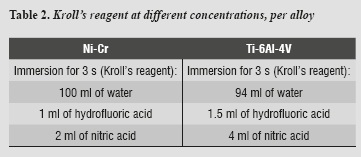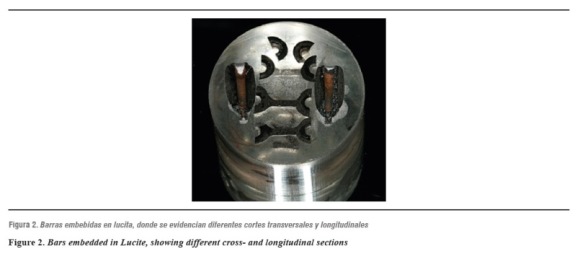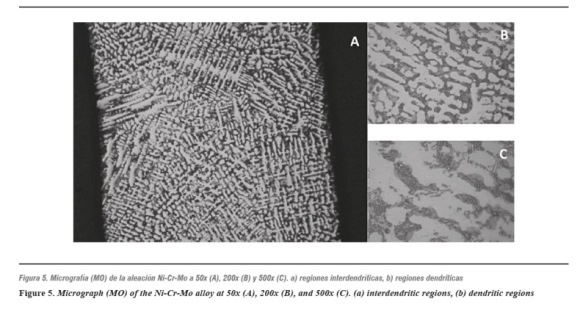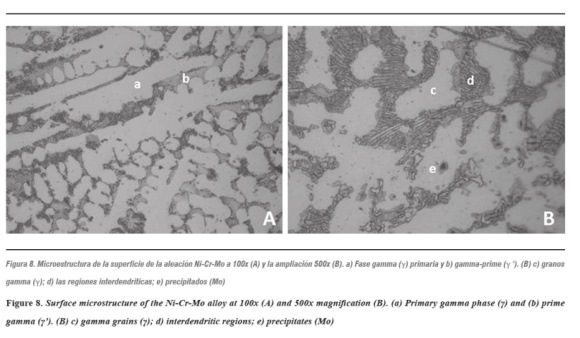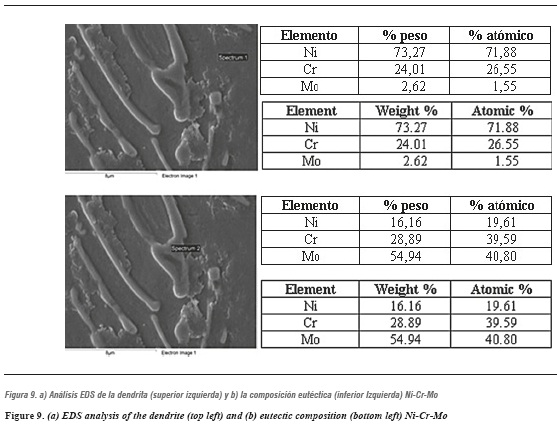Servicios Personalizados
Revista
Articulo
Indicadores
-
 Citado por SciELO
Citado por SciELO -
 Accesos
Accesos
Links relacionados
-
 Citado por Google
Citado por Google -
 Similares en
SciELO
Similares en
SciELO -
 Similares en Google
Similares en Google
Compartir
Revista Facultad de Odontología Universidad de Antioquia
versión impresa ISSN 0121-246X
Rev Fac Odontol Univ Antioq vol.25 no.1 Medellín jul./dic. 2013
ORIGINAL ARTICLES DERIVED FROM RESEARCH
METALLOGRAPHIC CHARACTERIZATION OF OVERDENTURE BARS MANUFACTURED BY OVERCASTING ABUTMENTS FOR DENTAL IMPLANTS1
Anthony Molina2; Diana Echeverri3; Maritza Parra3; Irvin J. Castro4; Herney Garzón5; Carlos H. Valencia6; Gilberto Olave7
1 Article resulting from a research project funded by a call for projects at Universidad del Valle. Article resulting from a research project as a requirement to obtain the title of Specialist in Oral Rehabilitation, Universidad del Valle, Cali (Colombia)
2 Materials Engineering Student, Universidad del Valle, Cali (Colombia). E-mail address: antigona24@hotmail.com
3 Graduate Intern. Specialization in Oral Rehabilitation. Universidad del Valle, Cali (Colombia)
4 Materials Engineer. MA with a focus in Materials Engineering. Universidad del Valle. Professor, School of Materials Engineering, Universidad del Valle, Cali (Colombia)
5 Oral Rehabilitation Specialist, Universidad Militar Nueva Granada, Fundación CIEO. Professor, Specialization in Oral Rehabilitation, Universidad del Valle, Cali (Colombia). E-mail address: herneygarzon@hotmail.com
6 Oral Implants and Reconstructive Dentistry Specialist, Universidad Militar Nueva Granada, Fundación CIEO. Professor, Specialization in Oral Rehabilitation, Universidad del Valle, Cali (Colombia)
7 Oral and Maxillofacial Implants Specialist, Universidad de Chile. Professor, Specialization in Oral Rehabilitation, Universidad del Valle, Cali (Colombia)
SUMBITTED: APRIL 12/2012-ACCEPTED: MAY 28/2013
Molina A, Echeverri D, Parra M, Castro IJ, Garzón H, Valencia CH, Olave G. Metallographic characterization of overdenture bars fabricated by overcasting abutments for dental implants. Rev Fac Odontol Univ Antioq 2013; 25(1): 26-43.
ABSTRACT
INTRODUCTION: the difficulty in handling conventional dentures in fully edentulous patients may be improved by using anchorage systems on dental implants for overdentures. The goal of this study was to conduct a metallographic characterization of a system of bars for overdentures by overcasting a metal base alloy on prefabricated titanium alloy abutments. METHODS: using a design of overdenture bars, made with an addition of prefabricated titanium (Ti-6Al-4V) and a metal base alloy (Ni65-Cr22%,5%-Mo9,5%), a metallographic characterization of the overcasting process was performed by analyzing its influence on the microstructure of two commercial dental alloys: Ti-6Al-4V and Ni65%-Cr22,5%- Mo9,5% (Wiron 99) using scanning electron microscopy (SEM), energy dispersive X-ray spectrometry (EDS), light microscopy analysis (LM), and stereomicroscopy (EM). RESULTS: the findings suggest that during overcasting a chemical bonding occurs due to the presence of oxygen between these two alloys, showing heterogeneous dendritic structures along the samples due to thickness irregularities on the bars and to precipitations of their molybdenum borders. CONCLUSIONS: from a metallographic perspective, the chemical bonding of the two alloys (Ni65-Cr22%, 5%-Mo9, 5% and Ti-6Al-4V) after overcasting suggests that overcasting between these two alloys is a viable option for placing structures on implant abutments.
key words: dental implants, overdentures, metallography, microscopy, segregation.
INTRODUCTION
Fitting conventional dentures on full edentulous patients may become sometimes difficult in individuals whose anatomical structures do not provide the prosthesis with sufficient support, stability, and retention allowing patients enough comfort to perform all of their oral functions efficiently.1 Oral implantology now offers the possibility of placing a minimum of 2 implants in the lower arch,2 and 4 in the maxillary arch,3 which by means of different anchoring systems and prosthetic designs may provide overdenture prostheses with significant increased stability, retention and sometimes support,4 improving the quality of life of those who use them..
The most commonly used anchoring systems for overdentures with implants are single anchors type O-Ball and Locator (and these are also the ones most commonly reported in the literature). The use of bars is also popular. The advantages of bars include high levels of retention and improved force distribution on implants due to the splinting effect;5 also, bars are a first-line option in presence of implants with inadequate parallelism.6 Slot et al describe the clinical behavior of bar designs as the most predictable of all, specifically for maxillary edentulous patients.7
Various metals and methods are used for this type of overdenture bars. The literature reports techniques such as welding methods—consisting on cylinders of gold alloys on which prefabricated gold type IV bars are welded—,8 casting methods—by splinting castable abutments and bars (either prefabricated or burred) using a wax pattern which is coated and then casted as a single unit in metals such as gold type III9-11 or in non-precious alloys such as Co- Cr—,12 and CAD/CAM milling methods—using titanium and Co-Cr alloys.6, 13, 14
The current high costs of burring methods show that making bars for overdentures on implants by means of casting is a technique still widely used. Casting a structure allows immediately assessing its adaptation and provides maximum strength due to its connectors rigidity.15
The materials of choice for casting are noble metal alloys because of their accuracy in reproducing details. An alternative to noble metals are nonprecious alloys, also known as base metals. Out of this group, the most commonly used alloy for such processes is the Co-Cr alloy, widely used in the elaboration of structures for removable prostheses. The advantages of base metal alloys include lower cost and high levels of hardness, strength, and modulus of elasticity, which offer wear resistance and the possibility of designing thinner structures.16
Among the base metal alloys for use in dentistry are Co-Cr and Ni-Cr. Several reasons support the use of nickel-chromium alloys in dentistry: nickel combines well with chromium to form a corrosion- resistant alloy, and the Cr-Ni and Cr-Ni-Be alloys are less expensive compared with noble and highly noble alloys. Regarding the questioned biocompatibility of Ni-Cr alloys, in 2006 Setcos et al17 published a review about the safety of dental alloys containing nickel, concluding that this element is found in many of the alloys used in dentistry, and that such alloys have a long history of successful use, with no reports of significant unwanted biological effects.
Although nickel has been reported as a moderate allergen, as suggested by specific tests for contact allergies, there is no evidence of patients with a significant risk of developing nickel sensitivity, solely attributable to exposure while using dental appliances and restorations.
There is no evidence of carcinogenicity associated with using intraoral dental alloys with Ni content. Furthermore, mucosal allergy to metals is a rare condition. One in vitro study demonstrates the low cytotoxicity of 11 alloys, including Ni-Cr, in an observation period of 10 months. The results support its successful use in the mouth.18
One of the main factors influencing alloy biocompatibility is corrosion. According to the proposed chemical and electrochemical classification of dental alloys (using the results obtained with the standard corrosion test described in ISO 10271) there exist lower corrosion resistance and greater ion release in non-precious alloys as Ni-Cr compared to alloys containing noble gold or palladium. However, evidence shows that the proportion of chromium content in the alloys may influence its corrosion resistance. When the content of chromium is greater than 18wt.% it ensures passivation of the alloy surface thus protecting against corrosion.19 It has been shown that the Ni and Mo release from Ni-Cr alloys with a Cr content of between 22.5 and 26% is similar, and its cytotoxic effects are not significantly different when compared with a highly noble Au-Pt alloy.20
In 2009, Viswanathan concluded that the corrosion resistance of Co-Cr alloys is higher than that of Ni- Cr alloys, but he used an alloy of 16% mass fraction in his study, accepting that Ni-Cr alloys with higher Cr levels (about 25%) show higher corrosion resistance levels due to a more uniform distribution of Cr in the alloy microstructure.21
Base metal alloys are generally harder, with higher values of elastic modulus and more resistance to torsional deformation at high temperatures, but they can also be more difficult to cast and pre-weld than gold-palladium or silver-palladium alloys. Non-noble metal alloys have higher melting temperatures than those of gold alloys, which may make casting more difficult. The hardness of these alloys may complicate finishing and polishing.16 which in turn may reduce casting accuracy.22, 23
Since the studies on casting dental structures on Ti implants have been mainly focused on noble metal alloys and on those containing non-precious metals such as Co-Cr, there are few reports available on the behavior of structures overcasted with Ni-Cr using Ti prefabricated abutments as an alternative to the manufacturing of suprastructures for dental implants.
This study suggests the possibility of making bars by overcasting one of the base metal alloys easily available in the market (Ni65%-Cr22,5%-Mo9,5%) on prefabricated titanium alloy abutments (Ti-6Al- 4V), keeping the structure's adaptation to implant, as provided by the prefabricated titanium addition, enjoying at the same time the advantages offered by the base metal properties and reducing production costs.
It is important to evaluate the behavior of this prosthetic design in vitro first, in order to determine relevant factors such as the type of bonding between the alloys and the corrosion potential and later determine the clinical feasibility and the recommendations for temporary or permanent use in patients. To this end, it is necessary to make a metallographic characterization of the possible type of bonding at the abutment-bar interface in order to determine its potential properties.
METHODS
For this study, 5 bars of approximately 10mm in length were made, splinting two abutments of dental implants (MIS) with acrylic resin patterns (Pattern Resin, GC). Final shape and thickness were given through manual waxing and calibration, maintaining a coating of 1.5 mm around the diameter of each abutment. A phosphate coating was used (Calibra Express) and, after hardening, it was brought to an oven at 800° C for 30 min for resin and wax evaporation. Casting of the Ni65%- Cr22,5%-Mo9,5% alloy (Wiron 99) was performed in an induction centrifuge at a casting temperature of about 1350° C. Finally, the alloy was left to cool in the open (figure 1) .
The alloys under study were Ti-6Al-4V and base metal Ni65%-Cr22,5%-Mo9,5%, Wiron 99 (Bego, Germany)—an alloy widely used for casting both fixed prostheses and structures on implants—. Table 1 shows the chemical composition of the alloys supplied by the manufacturer.
Surface preparation was made by manual polishing with silicon carbide paper number 180, 220, 280, 320, 400, 600, 1000, and 1200, according to the ASTM E3 standard, and then surfaces were polished with wet wipes containing particles of 0.3 and 1 micron; they were then rinsed and dried. Precautions were taken when polishing the Ti alloy as it undergoes transformations if any deformation is produced on it.
The test tubes were prepared by washing with acetone and distilled water in ultrasound. Microstructural revelation was conducted in two stages using Kroll's reagent in two different concentrations (table 2), after making transverse and longitudinal sections to observe microstructural variation from the bar surface to the abutment (figure 2), in order to inspect the microstructure through an optical microscope (Oliympus, GX 41F) ) at different magnifications. They were also embedded in Lucite to keep the test tubes edges.
Some tests were also made in a scanning electron microscope (SEM) and using energy dispersive X-ray spectrometry (EDS) (JEOL, Model JSM- 6490LV/Oxford Instruments) of the Universidad del Valle School of Materials Engineering. There were also macro-level analyses in a stereomicroscope (Nikon, C-LEDS).
RESULTS
The stereomicroscopy analyses showed bars with surface irregularities, roughness, porosity, and heterogeneity (figures 3 y 4), revealing faults during piece formation, which could potentially affect not only mechanical behavior but also resistance to corrosion.
The microstructure observed after etching by MO is displayed in figure 5 which shows that Ni-Cr- Mo alloys are made of a dendritic gamma-phase structure and an interdendritic component of Cr and Mo carbides.
Figure 6 (left) reveals an interface formation, which may be the evidence of a chemical anchoring rather than a mechanical one. Higher magnifications (right) showed the same dendritic structure, typical of the of Ni-Cr-Mo alloys.
The Ti-6Al-4V alloy suffered a microstructural change due to surface overcasting of the Ni-Cr-Mo alloy. This process was carried out at a temperature of 1350° C, cooled in the open, yielding a light shaded microstructure of Α Widmanstätten plates surrounded by a darker Β phase (figure 7).24-26
Precipitations of grain edges may also be observed at higher magnifications (figure 8) These are distinctive of this type of alloys, which get toughened by solid solutions.24
The micrograph on figure 8 also shows two phases: primary boundary and grain. The main phase, also known as the homogeneous one, keeps a dendritic nature. The grain boundary groups show possible compounds of Cr and Mo carbides.27
DISCUSIÓN
From a top view (figure 4), one may note that, due to manual waxing, thickness is not fully uniform along the bar; as a consequence, the thicker areas produce thicker dendritic microstructures due to slower heat dissipation which enables them better development—while the opposite occurs in the thinner areas..
Figure 7 shows a transformation of the Ti-6Al-4V alloy into an a Widmanstätten structure, which experiences a decrease in elongation percentage and yield strength compared to the annealed and forged alloys of Ti-6Al-4V. The tensile strength produced in this phase is smaller in comparison to annealed structures but higher than those of forged structures. The higher the strain amplitude the bigger crack nucleation in slip bands of a Widmanstätten plates. As cracks spread through the microstructure, they branch off, hindering their growth and showing higher resistance to crack growth, that is to say, on the Widmanstätten structure, crack nucleation is faster than on the annealed one, but its propagation is slower. This microstructure is characterized by high tensile strength, reduced ductility, and low compressive stress—which may be favorable characteristics for the final behavior of the Ti-6Al- 4V alloy subjected to overcasting.24, 28
As for the Ni-Cr alloys, some studies have shown that when subjected to heat at temperatures used in casting techniques they produce thickened dendritic microstructure and decreased alloy hardness, as well as decreased resistance—typical characteristics of the transformation processes of alloys by casting.26, 29
Precipitations in grain edges are characteristic of this type of alloys (figure 8). This is generally attributed to the tendency of molybdenum to segregate in grain boundaries.30 Therefore, grain boundaries act as brakes to the progress of dislocations, which causes creep resistance.24 Also, high temperature treatments and firing simulated processes have been shown to produce microstructural effects on alloys, surface oxides, corrosion and physical properties.31, 32
The casted structure is predominantly dendritic (figure 8) and dendrites in this structure are known to have concentrations of the metals (Ni-Cr), different from the concentration of metals in the interdendritic spaces. This is due to the solidification process, in which dendrites initially solidify forming a gamma phase (Γ) or primary phase, and a prime gamma phase (Γ') —an intermetallic phase responsible for the material's high temperature resistance—and therefore they have different levels of resistance to both chemical agents and electrochemical attacks.27
These precipitates are probably composed of Cr and Mo carbides (mainly Mo), and if we compare this microstructure with the findings of earlier research, we may find out that they are similar.33 The microstructure of Ni-Cr-Mo has a softer phase than that of the interdendritic structure, so a variation in the proportion of these phases caused by different cooling rates may make the material exhibit different mechanical properties. Moreover, the fact that there are two phases means that there is a potential difference between them, and if this proportion varies there will be a different behavior to corrosion.
These elements (Cr and Mo) contribute to the strengthening of the solid solution of phases occurring in the dendritic microstructure, which precipitates are dispersed throughout the matrix—seen as formation of eutectoid elements—showing the solid extensive solubility of chromium in nickel, as a result of hardened binary alloys.27
Figure 9 (a) shows that Mo is less abundant than Cr; however, fewer concentrations of Mo make the alloy more susceptible to pitting. The tendency of Mo to separate the interdendritic regions in the melting zone has been well demonstrated in the literature.34The dendritic structures are also evidence of segregation and heterogeneity in the material— this has been shown by EDS analyzes.34
In figure 9 (b) the high content of molybdenum corresponds to the presence of a carbide M6C, where M corresponds to the presence of molybdenum or silicon, and silicon is present because it increases the fluidity of the alloy during casting.35
Figure 10 highlights the interface formed between the nickel and titanium alloys and their respective EDS analysis showing the components of the two alloys used (such as Ti and Cr in the interface), that may influence corrosion mechanisms. Whether it is a positive or a negative influence depends on subsequent electrochemical results.
It is also important to note the presence of oxygen, which indicates the presence and formation of oxides that may be Cr2O3, MoO3 or nickel, and although they offer very good anticorrosion properties, being oxides they may become fragile due to their ceramic behavior. It is very important to mention, however, that it is not usual for this interface to be exposed to the surface.
These analyses clearly show that the interface is defined by an oxide layer because the production process is performed without a protective atmosphere.
Some of the SEM results show a decrease in the contents of Cr and Ni in the dendrites. Roach et al36 found out that, after casting, the alloys with 14- 22% of Cr and 9-17% of Mo showed a decrease in the Cr and Mo contents in the oxide surface, indicating a decrease in corrosion, although it is not very significant in all the cases.
CONCLUSIONS
Among the limitations of this study is a chemical bonding of the two alloys (Ni65%-Cr22,5%- Mo9,5% and Ti-6Al-4V) following the overcasting process, as an exchange of elements between the elements is identified. From a metallographic perspective, this suggests that overcasting between these two alloys is a viable option for fitting structures on implant abutments.
A change was observed in the Ti-6Al-4V alloy microstructure after overcasting, generating a laminar structure of an Α Widmanstätten phase, which provides a better flow behavior, increased toughness and improved resistance to crack propagation.
The bars did not present a homogeneous thickness of the Ni65%-Cr22,5%-Mo9,5% alloy coating on the pillar. This produces greater microstructural heterogeneity, directly affecting the material and altering its mechanisms of corrosion; therefore, the bar manufacturing process must be standardized with prefabricated structures in order to ensure better control of the final microstructure.
In those areas of the bars with greater thicknesses, the samples developed dendrites with different thicknesses compared with thinner sections. This may be due to lower cooling rates in thicker areas.
During the casting process, an inert atmosphere should be ensured so that the generated interface does not present oxide formation, which may affect its mechanical properties.
Electrochemical corrosion tests and mechanical test are required to evaluate the behavior of these structures, simulating the characteristics of the oral environment.
REFERENCES
1. Mericske-Stern RD, Taylor TD, Belser U. Management of the edentulous patient. Clin Oral Implants Res 2000; 11(1): 108-125. [ Links ]
2. Batenburg RH, Meijer HJ, Raghoebar GM, Vissink A. Treatment concept for mandibular overdentures supported by endosseous implants: a literature review. Int J Oral Maxillofac Implants 1998; 13(4): 539-545. [ Links ]
3. Sadowsky SJ. Treatment considerations for maxillary implant overdentures: a systematic review. J Prosthet Dent 2007; 97(6): 340-348. [ Links ]
4. Fueki K, Kimoto K, Ogawa T, Garrett NR. Effect of implant- supported or retained dentures on masticatory performance: a systematic review. J Prosthet Dent 2007; 98(6): 470-477. [ Links ]
5. Trakas T, Michalakis K, Kang K, Hirayama H. Attachment systems for implant retained overdentures: a literature review. Implant Dent 2006; 15(1): 24-34. [ Links ]
6. Moeller MS, Duff RE, Razzoog ME. Rehabilitation of malpositioned implants with a CAD/CAM milled implant overdenture: a clinical report. J Prosthet Dent 2011; 105(3): 143-146. [ Links ]
7. Slot W, Raghoebar GM, Vissink A, Huddleston Slater JJ, Meijer HJ. A systematic review of implant-supported maxillary overdentures after a mean observation period of at least 1 year. J Clin Periodontol 2010; 37(1): 98-110. [ Links ]
8. Waddell JN, Payne AG, Swain MV, Kieser JA. Scanning electron microscopy observations of failures of implant overdenture bars: a case series report. Clin Implant Dent Relat Res 2010; 12(1): 26-38. [ Links ]
9. Lothigius E, Smedberg JI, De Buck V, Nilner K. A new design for a hybrid prosthesis supported by osseointegrated implants: 1. Technical aspects. Int J Oral Maxillofac Implants 1991; 6(1): 80-86. [ Links ]
10. Naert I, Gizani S, van Steenberghe D. Rigidly splinted implants in the resorbed maxilla to retain a hinging overdenture: a series of clinical reports for up to 4 years. J Prosthet Dent 1998; 79(2): 156-164. [ Links ]
11. Zitzmann NU, Marinello CP. Implant-supported removable overdentures in the edentulous maxilla: clinical and technical aspects. Int J Prosthodont 1999; 12(5): 385-390. [ Links ]
12. Kramer A, Weber H, Benzing U. Implant and prosthetic treatment of the edentulous maxilla using a bar-supported prosthesis. Int J Oral Maxillofac Implants 1992; 7(2): 251- 255. [ Links ]
13. Spyropoulou PE, Razzoog ME, Duff RE, Chronaios D, Saglik B, Tarrazzi DE. Maxillary implant-supported bar overdenture and mandibular implant-retained fixed denture using CAD/CAM technology and 3-D design software: a clinical report. J Prosthet Dent 2011 ;105(6): 356- 362. [ Links ]
14. Visser A, Raghoebar GM, Meijer HJ, Vissink A. Implant- retained maxillary overdentures on milled bar suprastructures: a 10-year follow-up of surgical and prosthetic care and aftercare. Int J Prosthodont 2009; 22(2): 181-192. [ Links ]
15. De Torres EM, Rodrigues RC, de Mattos Mda G, Ribeiro RF. The effect of commercially pure titanium and alternative dental alloys on the marginal fit of one-piece cast implant frameworks. J Dent 2007; 35(10): 800-805. [ Links ]
16. Kelly JR, Rose TC. Nonprecious alloys for use in fixed prosthodontics: a literature review. J Prosthet Dent 1983; 49(3): 363-370. [ Links ]
17. Setcos JC, Babaei-Mahani A, Silvio LD, Mjor IA, Wilson NH. The safety of nickel containing dental alloys. Dent Mater 2006; 22(12): 1163-1168. [ Links ]
18. Wataha JC, Lockwood PE, Nelson SK, Bouillaguet S. Long-term cytotoxicity of dental casting alloys. Int J Prosthodont 1999; 12(3): 242-248. [ Links ]
19. Manaranche C, Hornberger H. A proposal for the classification of dental alloys according to their resistance to corrosion. Dent Mater 2007; 23(11): 1428-1437. [ Links ]
20. Al-Hiyasat AS, Bashabsheh OM, Darmani H. Elements released from dental casting alloys and their cytotoxic effects. Int J Prosthodont 2002; 15(5): 473-478. [ Links ]
21. Viswanathan S. Electrochemical behavior of Co-Cr and Ni-Cr dental cast alloys. Trans Nonferrous Met Soc China 2009; 19: 785-790. [ Links ]
22. Kan JY, Rungcharassaeng K, Bohsali K, Goodacre CJ, Lang BR. Clinical methods for evaluating implant framework fit. J Prosthet Dent 1999; 81(1): 7-13. [ Links ]
23. Sahin S, Cehreli MC. The significance of passive framework fit in implant prosthodontics: current status. Implant Dent 2001; 10(2): 85-92. [ Links ]
24 Leyens C, Peters M. Titanium and Titanium alloys fundamentals and applications. Weinheim: Wiley VCH; 2003. p. 4-50. [ Links ]
25. Gil FJ, Ginebra MP, Manero JM, Planell JA. Formation of a-Widmanstatten structure: effects of grain size and cooling rate on the Widmanstatten morphologies and on the mechanical properties in Ti-6Al-4V alloy 2001. J Alloy Comp 2001; 329 (1-2): 142-152. [ Links ]
26. Hong Q, Qi YL, Zhao YQ. Effect of rolling process on microstructure and properties of Ti600 alloy plates. Rare Metal Mat Eng 2005; 34(8): 1334-1337 [ Links ]
27. Faot F, Jose da Silva W, Matheus RC, Del Bel Cury AA. Microstructural characterization of Ni-Cr-Mo-Ti and Ti- 6Al-4V alloys used in prosthetic abutments. Rev Odonto Cienc [revista en línea] 2009 [fecha de acceso 4 de agosto de 2009]; 24(4): 401-405 URL disponible en http://www. revistaseletronicas.pucrs.br/ojs/index/php/index [ Links ]
28. ASM International, Handbook Committee, Vander Voort GF. Metallographic and Microstuctures. 10.a ed. California: ASM International 2004; 9: 458-476. [ Links ]
29. Goodall TG, L. A. The metallography of heat treatment effects in a nickel-base casting alloy. Aust Dent J 1979; 24(4): 235-237. [ Links ]
30. Banovic SW, DuPont JN, Marder AR. Dilution and microsegregation in dissimilar metal welds between super austenitic stainless steels and Ni base alloys. Sci Technol Weld Join 2002; 7(5): 374-83. [ Links ]
31. Roach MD, W. J. Use of X-ray photoelectron spectroscopy and cyclic polarization to evaluate the corrosion behavior of six nickel-chromium alloys before and after porcelain- fused-to-metal firing. J Prosthet Dent 2000; 84(6): 623-634. [ Links ]
32. Johnson T. Surface analysis of porcelain fused to metal systems. Dent Mater 2006, 22(4): 330-37. [ Links ]
33. Silva J, Sousa L, Nakasato RZ, Codaro HM. Electrochemical and Microstructural study of Ni-Cr-No alloys used in dental prostheses. Mater Sci Appl 2011; 2: 42-48. [ Links ]
34. Perricone MJ, Dupont JN. Effect of Composition on the Solidification Behavior of Several Ni-Cr-Mo and Fe-Ni- Cr-Mo Alloys. Metall Mater Trans A 2006; 37(4): 1267- 1280. [ Links ]
35. Bauer J, Costa JF, Carvalho CN, Grande RH, Loguercio AD, Reis A. Characterization of two Ni-Cr dental alloys and the influence of casting mode on mechanical properties. J Prosthodont Res 2012; 1016: 1-8. [ Links ]
36. Roach MD, Wolan JT, Parsell DE, Bumgarder JD. Use of X-ray photoelectron spectroscopy and cyclic polarization to evaluate the corrosion behavior of six nickel-chromium alloys before and after porcelain-fused-to-metal firing. J Prosthet Dent 2000; 84(6): 623-634. [ Links ]











 texto en
texto en 



